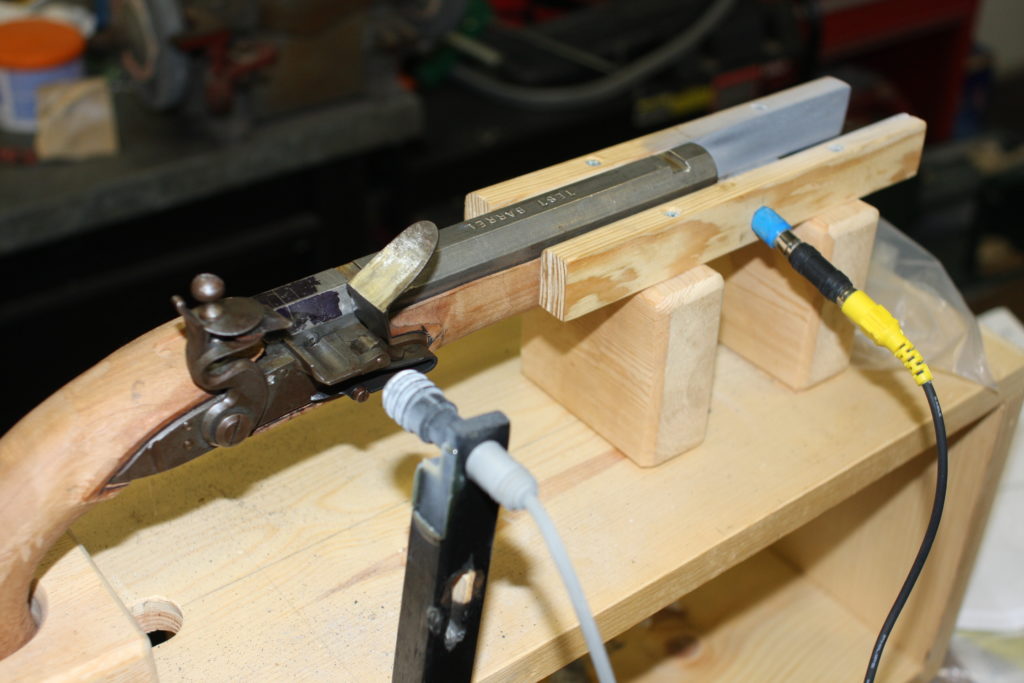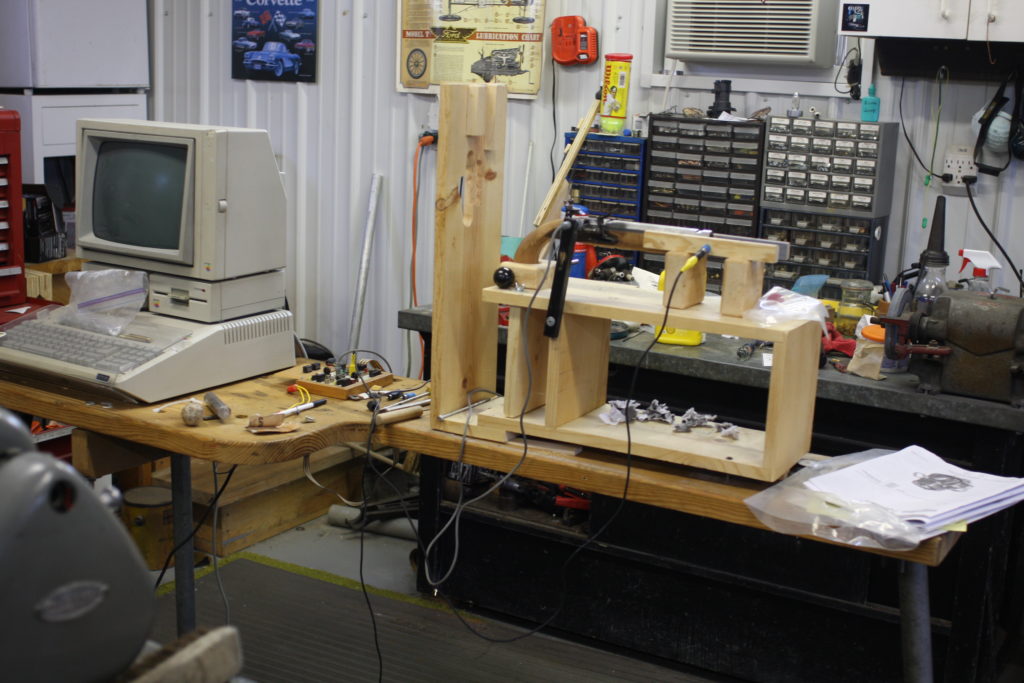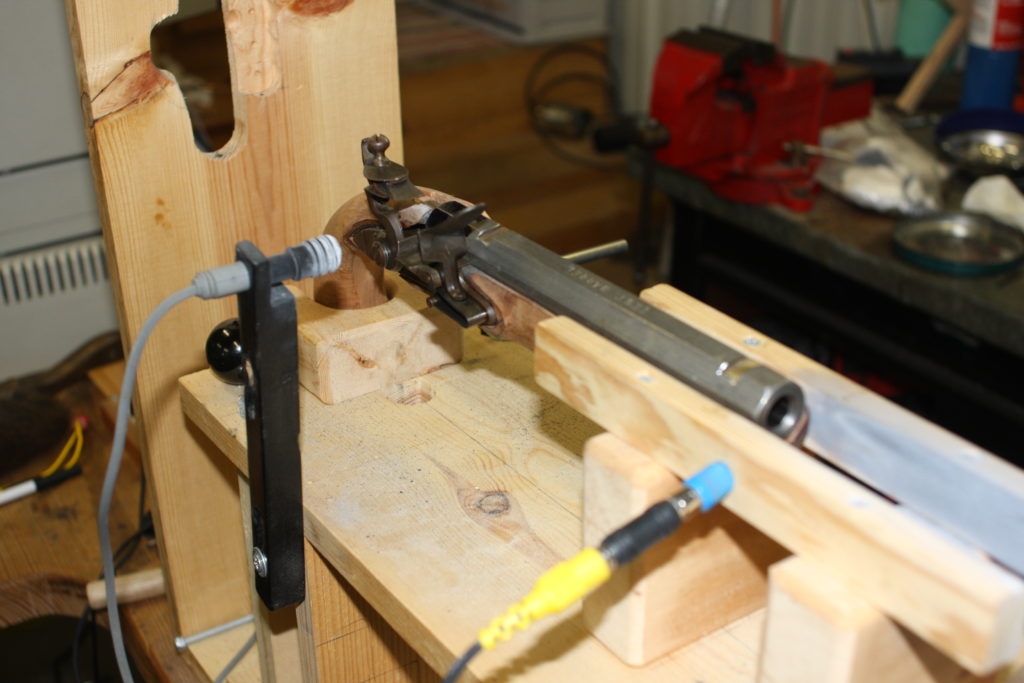Filling a flintlock touch hole with priming powder causes a slower ignition. The pan fire has to burn through instead of flash through the vent. Is this “fuse effect” true? Can the difference be measured? Are the “hang fires” experienced by black powder shooters caused by something else? Reporting the answers to these questions is the purpose in this article.
The purpose of this test was to see if there was a measurable delay in ignition when a straight cylinder vent was filled with priming powder. (We did not deal with vent liners in this test.) For the purpose of this experiment I will define this “fuse effect” as an ignition delay caused by the priming powder having to burn its way through the vent to ignite the main charge instead of “flashing” through the vent. I’m personally not fond of the term because it implies that we know what caused the delay. I like the term “hang fire” because it does not suggest a cause.
The test was set up using a fixture we used earlier to time lock ignition speeds. We used a “pistol” with a barrel stub, small Siler lock, and my computer with photo cells “looking” at the pan and barrel muzzle. The barrel is loaded with 30 gr 3fg and a sabot to hold powder in place. The pan is primed, and ignited with a red hot wire to eliminate lock variables. Between firings, the barrel is wiped with two patches, a vent pick used, and compressed air is blown through the vent to insure that the vent is clean. The pan is primed with Null B close to the barrel. The only difference between the two test phases was that the vent was completely empty in one, while in the other, we picked priming powder into the vent until no more would go in.
The barrel used was octagon 7/8” across the flats and was .45 caliber. It had a flat flint-type breech. The vent was a straight cylinder with a 1/16” diameter approximately .21 inches in length. Time starts when the pan photo cell is triggered and stops when the barrel photo cell is triggered. Thus barrel time is included in this test, however this obviously the same for both vent conditions.
We recorded 5 trials for each vent condition. The average time for the clean, empty vent was .028 seconds. The filled vent average was .031 seconds. As you would expect, the slowest time we recorded was in the filled vent phase (.0363). However the fastest time of the day was also in the filled vent phase (.0233). (We also did a single clean vent trial where we banked the prime away from the vent and recorded at time of .067 – more than two times slower than the clean vent average.)
These averages are quite close together. We expected a larger difference because our ears tell us a hang fire has taken place. And, here is the most unusual finding. The fastest time (.0233) we recorded sounded as if it was a hang fire. The slowest time (.0363) recorded sounded like a sharp crack – no hang fire – sounded like a .22 rim fire. This reinforces a belief I have long held that our eyes and ears are terrible tools for judging flint events.
This all makes me wonder what we are really hearing. Maybe our ears send us false information. Consider this: You are three shots into a target and have 3 tens. You shoot the 4th shot and it’s a nine. Sounded fast, but you think it was just you. You shoot the 5th shot, and it has an audible hang. You look through the scope, and no. 5 is back in the 10 ring. Maybe the fourth shot was slow, the fifth shot was fast, and your ears are at fault. With what we learned here, it could be possible. I truly don’t know the answer. Sometimes experiments leave you with more questions than answers. I do know that I trust my ears less than the numbers.
There are so many variables that can cause delays that in most cases it can be impossible to rule out all but one. That was the purpose in our experiment. We wanted to put a number on the amount of delay, if any, caused by packing a cylinder vent with priming powder.
The delays we found were measurable but not large enough to account for the delays we have measured in pan ignition – where the variables were flint edges, priming, particle size, and location of the prime in the pan. I have measured far larger time variations caused by these variations. The other big factor is the delay caused by fouling in the vent. A vent full of priming is one thing, but a vent filled with fouling is quite another. Besides causing huge hang fires, I believe fouled vents are the flint shooter’s biggest cause of failures to fire.
If I were to list the top causes for delays based on my testing they would be:
1. Lack of good spark production from good flint edge
2. Improper priming location in the pan with good priming powder
3. Vent not absolutely clear of fouling.
(A clean vent filled with prime is not a major cause IMHO.)




Leave a Reply
You must be logged in to post a comment.